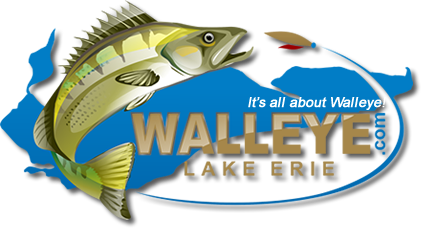 Thanks: 0
Thanks: 0
 Likes: 0
Likes: 0
Results 1 to 10 of 13
-
06-25-2020, 05:18 PM #1
 Fishin with Chad and Tiffany 6/25/2020
Fishin with Chad and Tiffany 6/25/2020
My last two days were "blow days" and my customers rescheduled to the fall, so no report.
This morning, the winds were better. At 5:30 they were light out of the WSW, and waves were 1foot or less (but, were 1-3's the further east we went).
The air temp was 62 degrees and the sky was clear to partly cloudy, but mostly clear.
We headed NE out of the launch and went up to the Canadian line...set up...and took it East at a speed of 2.2-2.4mph.
If you go east of Kelly's (out about 6-8 miles) watch out of the perch nets...they're all over the place and all the way up to the line.
For those visiting Lake Erie and don't know about the perch nets....Know this: they have to set them running south to north, so the single flag is on the south end of the trap net and the double flag is on the north end. You can pass below the single or above the double, but it's best not to pass through them, especially if you're trolling! That's an expensive mess you don't want.
What worked for us today were Bandits with a 2oz snap weight at 50/75, and a 3oz weight rigged 30/80 (ie: let 30' of line out...add the snap weight and let another 80' of line out, for a total of 110, and then attach the Off Shore board).
Reef Runner Mag 44 in the Bare Naked Perch at 75 back (unassisted)
Dipsies on the 1 setting at 54 back and the 3 setting at 65 back. Spoon colors were Red Headed Wonder Bread, Blueberry Muffin, and a hammered copper one with one side green with black stripes over the green.
I am fishing with this fun couple again tomorrow. They did a great job today, and picked up the dipsey program pretty quickly for never having run them before.
Tomorrow's winds should be lighter than today's, so it's going to be an enjoyable morning!
Stay tuned...
Capt JulsCaptain Julia "Juls" Davis
[email protected]
www.julswalleyefishingadventures.com
https://www.facebook.com/JulsWFA?ref=br_rs
Specializing in 1-3 person walleye and perch charters
-
06-25-2020, 07:19 PM #2

Nice report again, Juls, and thanks for the info about the perch netting. Good reminder for all of us.
Polar Kraft Frontier 179 WT
Yamaha 90 4 stroke
Suzuki 9.9 EFI
Minn Kota Terrova iPilot 80# w/ US2
Lowrance Elite Ti2 9 inch
Lowrance Elite 5x
-
06-25-2020, 08:37 PM #3

Hey Juls.We also fished same area today and did well.Our dipsey leads were about same as yours and caught majority of fish.3 setting @65 and 70 and 1 setting @45 and 50.We ran two unassisted bandits at 70 and 80 that caught a few fish.Question,putting weights on those cranks,worried they might catch those dipsey.We just drift board and crank straight back between dipseys when we set them out.Anything special you do differently when adding weight to cranks?
-
06-26-2020, 10:23 AM #4

Thanks for a nice report. Hope you are killing it this morning also, or done already.
I know I've heard other people running stickbaits 50 feet behind a weight, like you describe. What advantage is there to running the weight that far back? I usually just run a 6 foot leader between weight and bait.
thank you,
Rickerd
-
06-26-2020, 01:05 PM #5

Use the lures natural diving depth at the desired feet back first, then add the needed weight to reach the depth you want to target. We used this system back many years ago, when people said "you did what".
-
06-26-2020, 05:19 PM #6

I don't do anything special. I go straight out the back when I'm putting them out. The dipsies are not near the motors, or center of the transome, so going straight out the back keeps them from tangling. Just pay attention to where everything is in the water and you shouldn't have any issues.
If you want the board to go straight back for a distance first, simply take the tension off and let it freespool straight back. By then, the dipsies are not even close to the boards or their line/lures.Captain Julia "Juls" Davis
[email protected]
www.julswalleyefishingadventures.com
https://www.facebook.com/JulsWFA?ref=br_rs
Specializing in 1-3 person walleye and perch charters
-
06-26-2020, 05:21 PM #7

You need to elaborate on how much more depth each ounce of weight will get them with a length of line out. Most don't know.

And, there are those that know, and talk with others... and, then, can't agree on what is correct. Been there done that. I was taught one way by an older charter Capt, and I have friends that were taught another. Who's right? lol
I use the Precision Trolling Data App. They have the 2oz snapweight option for the most popular Lake Erie cranks, and then I know for sure where my bait is.
But, then again, sometimes I use that info from old "Bigfoot" LaCourse, who I think was one of the best of the Lake Erie trollers.
Last edited by Capt Juls; 06-26-2020 at 05:27 PM.
Captain Julia "Juls" Davis
[email protected]
www.julswalleyefishingadventures.com
https://www.facebook.com/JulsWFA?ref=br_rs
Specializing in 1-3 person walleye and perch charters
-
06-26-2020, 08:31 PM #8

What size Dipseys do you run and do you use the rings?
-
06-26-2020, 11:17 PM #9

So first off back in the early to mid 1990s, there wasn't many other charter captains to compare notes with. As a matter of fact, I didn't know of any. It was frowned upon to troll at all in Michigan at that time and if you pulled those big orange boards in Ohio... Well lets just say keep your eyes open well. Back then you started spring off with hot-n-tots, then to say deep jr. thundersticks, then on to mag warts late. Then one day at a captains assoc. fishing show I met the man at off shore tackle, as we talked, he introduced me into the world of snap weights. Jump ahead to fishing, I now found out I could fish my favorite (deep jr. thunderstick) at any depth I needed, and this was a game changer. Back in the day as the lake cleared up from the ugly mess it was noted for, light penetrated and often sent the walleye deep. Back then there was not one data source to go to, I had a precision trolling guide for lure depth and a off shore snap weight guide for weight depth, then eventually made my own format combining those two guides into one. I mainly used 3/4, 1, 1 1/2, & 2 oz. weights as anything over 2 oz. was seldom ever needed in the depths I normally fished. I could run my deep jr. thundersticks down to 30' or so if I needed to. My point is, do some research, learn the depth for the lure you use. Pull up the data for your preferred lures and pull up a off shore snap weight guide, combining these two will give you a much more accurate plan than just pulling up a precision trolling lure using a 2 oz. weight. Lure type, weight, line type and troll speed will all effect the depth. Combine this info for your trip, find the walleye depth, check your new guides you printed, adjust your weight and fish. You will find that you do NOT need to have every lure in the tackle shop, but rather some good lures, good color combos, and snap weights. Hint: use a different weight on each side to start, say 1 oz. port and 2 oz. starboard for example, when one hits best, switch the other side to match.
-
06-27-2020, 05:10 AM #10
 Captain Julia "Juls" Davis
Captain Julia "Juls" Davis
[email protected]
www.julswalleyefishingadventures.com
https://www.facebook.com/JulsWFA?ref=br_rs
Specializing in 1-3 person walleye and perch charters
-
Similar Threads
-
Fishing with Aaron and Tiffany Battrick 9/21/16
By Capt Juls in forum Western Lake Erie Fishing REPORTSReplies: 11Last Post: 09-23-2016, 07:00 PM -
anybody fishin
By fishnfunaddict in forum Western Lake Erie Fishing REPORTSReplies: 0Last Post: 03-03-2016, 07:35 AM -
fishin on sunday
By JACKed UP in forum Western Lake Erie Fishing REPORTSReplies: 11Last Post: 03-09-2014, 12:57 AM -
Just fishin
By riverrat in forum Western Lake Erie Fishing REPORTSReplies: 0Last Post: 08-03-2011, 09:15 PM -
just fishin
By riverrat in forum Western Lake Erie Fishing REPORTSReplies: 0Last Post: 07-28-2011, 05:06 PM








 Reply With Quote
Reply With Quote



As soon as the fish move in there...
Sept 1 thru present report